
45 minute read
News and Updates
News &Updates
AIT Consulting provided technical assistance and support to several Asian Development Bank funded projects. Two recent activities are highlighted below: maintained as per project requireties that are part of the ADB-financed
Advertisement
ADB performs Asset Inspection in Sri Lanka, Project Procurement-Related Review in Mongolia
Hambanthota, Sri Lanka: H/Vihargala School was one of the five schools inspected for ADB
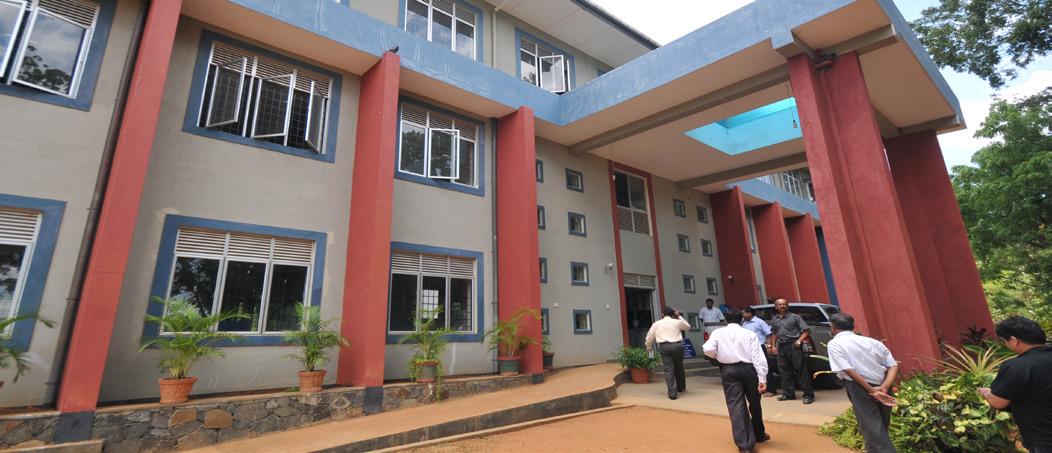

The Asian Development Bank’s (ADB) Office of Anticorruption and Integrity conducted a project procurementrelated review (PPRR) of selected ongoing ADB-financed projects to determine compliance with applicable ADB’s policies, guidelines, and loan/grant agreements. In 2012, ADB engaged the services of AIT Consulting to conduct asset inspections and project procurement reviews of two PPRRs relating to ADB-financed projects in Sri Lanka and Mongolia.
Erdene Soum, Mongolia One of the highway access roads reviewed for In Sri Lanka, five educational faciliproject “Education for Knowledge Society Project” (EKSP) were inspected. EKSP aims to improve the quality, relevance, management, effectiveness, and equity of access to secondary and tertiary education, and training programs in rural and disadvantaged areas of Sri Lanka.
While in Mongolia, the construction of a railway crossing, two link roads and an access road were reviewed to determine whether quality was project compliance
ments.
ADB's Transport Forum promotes Sustainable Transportation
“Inclusive and Sustainable Transport” was this year’s theme in the ADB’s transportation forum held on 6-8 November 2012 in Manila, Philippines. The most critical issues facing transport in the Asia Pacific region today were discussed and debated in the forum. The forum program spanned the breadth of current issues in inclusive and sustainable transport including key sessions on urban transport, road safety, green freight and transport technologies, climate change resilience, mode choice, socially inclusive transport, road asset management, and cross-border transport.
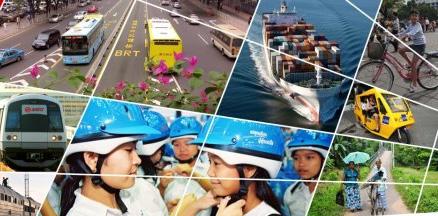
The event brought together the world's leading transport experts, representatives from various consulting organizations, key developing member country officials, and ADB transport experts. Various government representatives, consulting organizations, and donor agencies joined the forum making the event ideal for knowledge exchange in themes covering future trends in transportation development, and professional networking.
During the meeting, ADB shared the leading aspects of their work in member countries covering building low-carbon, safe, accessible, and affordable transport systems. Engr. Samat Sukenaliev, Project Development Engineer, represented AIT Consulting in this forum.
AIT, Thailand Dr. Naveed Anwar (left) discusses potential partnerships with H.E. Prof. Obaidullah Obaid, Minister of Higher Education, Afghanistan (right) and other officials from MoHE Afghanistan
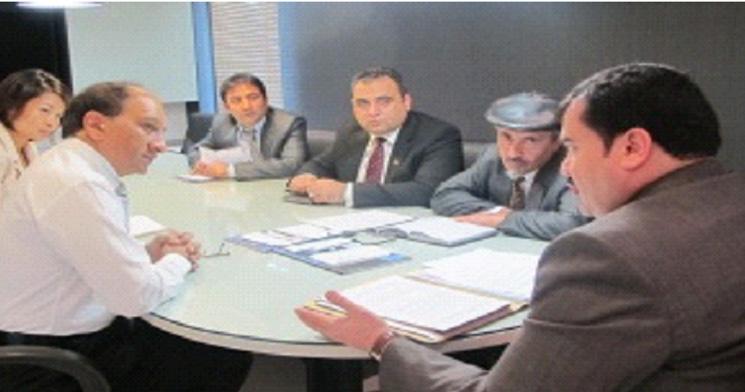

AIT, Thailand L-R: Mr. Mohammad Qaasim, Project Manager, MoHE-SHEP Partnership Project; Dr. Naveed Anwar, Executive Director, AIT Consulting; Dr. Jonathan Shaw, Executive Director, AIT Extension; Prof. I.M. Pandey, Vice President of Academic Affairs, AIT; Prof. Habibullah Habib, Chancellor, Kabul University; H.E. Prof. Obaidullah Obaid, Minister of Higher Education, Afghanistan; Prof. Said Irandoust, President, AIT
Afghanistan’s Ministry of Higher Education (MoHE Afghanistan) is set to further rehabilitate and strengthen the quality of the country's education system by implementing the project “Strengthening Higher Education Program” (MoHE-SHEP). The program, funded by the World Bank, focuses on strengthening institutional development, standards and content development, training and professional development, study abroad programs, English language training, and an Afghan Master’s program that supports 12 core universities in Afghanistan and nine regional universities. In 2008, MoHE-SHEP established a partnership with the Asian Institute of Technology (AIT). A total of seven students from Afghanistan completed higher education at the Institute since then. Currently 15 candidates are pursuing degrees in AIT. H.E. Prof. Obaidullah Obaid, MoHE Afghanistan, visited AIT in October 2012 to sign a Memorandum of Understanding (MoU) to affirm the current collaboration with the Institute. His Excellency also expressed MoHE Afghanistan’s desire to join the AIT Council. He then announced that they wish to send more than 100 students to study at the undergraduate level, and about 30- 40 students for study at the master’s and doctoral degree programs. MoHE Afghanistan also met with AIT Consulting (AITC) to discuss the need for a staff development program in order to boost the quality of faculty members in Afghanistan. In response, AITC is now working with AIT Extension, a center that brings over 25 years of experience in training and continuing education, to organize two professional development programs on Basic Research Methodology and Quality Assurance for faculty members and research staff from Afghan universities in early 2013.
AIT, Thailand Dr. Naveed Anwar with the training participants from Balkh University, Afghanistan outside the AIT Consulting office

MoHE Afghanistan continues to uplift the quality of the country's education system through the AIT-BU (Balkh University) partnership. The Ministry requested AIT Consulting to assist in organizing a professional development program on Research and Teaching Methodologies for 14 faculty members from the Faculty of Engineering. bilities on teaching methodologies, the key issues and concepts of the research process, and enhance their knowledge and skills and conducting research in the areas of engineering and sciences. This program used a variety of training methods, combining interactive lectures with a balance of participatory learning techniques such as group discussions, brainstorming, demonstration, observation, project work, case studies, and handson practices. Field visits to Kasetsart University, Mahidol University, and Thailand Science Park (NSTDA) were also incorporated to observe the educational facilities' best practices.
Resource persons and facilitators for the training courses were drawn from AIT, prominent academic institutions, and training institutions in Thailand. For more information about the training please see page 40.
MYANMAR
UNESCAP and UN HABITAT support Myanmar's Building Code Initiatives Collaboration Efforts in Myanmar
Following the success of its recently completed project “Incorporating Environmental Sustainability and Disaster Resilience in Building Codes,” the United Nations Economic and Social Commission for Asia and the Pacific (UNESCAP) showed an increased interest to support the Myanmar National Building Code (MNBC) project. Earlier, UNESCAP partnered with AIT for the analysis of the building codes of nine countries in the Asia-Pacific region and documented seven good practices for green and resilient buildings while focusing on building code enforcement. MNBC’s goal in developing the code is to prioritize protection against the uncertain occurrence of the two most common natural disasters in Myanmar: earthquakes and strong winds. The Ministry of Construction (MOC) and its technical partner the Myanmar Engineering Society (MES) have been working towards developing and enforcing proper and stricter building codes through the Myanmar Golden Wing Co., Ltd. (MGW), a wellreputed local real estate developer, is planning to build a high-end residential condominium set to become the tallest building in the country. The new condominium called Diamond Inya View Palace Building, located near Inya Lake, Yangon, will have an approximate floor area of 106,680 sqm and will be 34-story tall, 9-stories higher than Myanmar’s current tallest building located in Mandalay, which is 25 stories tall. Myanmar National Building Code (MNBC) project. The ministries are drafting the code in accordance with ASEAN building standards to bring Myanmar in line with neighboring countries and improve the structural elements of the buildings in the country. UN-HABITAT, the United Nations Human Settlements Program, an agency that promotes socially and environmentally sustainable towns and cities, is leading this project and has selected various regional and international experts and institutions to review the seven different parts: 1) Planning, Environment, Administration and Legislation, 2) Architecture and Urban Design, 3) Structure, 4) Soil and Foundation, 5) Building Services, 6) Materials and Construction Practices, and 7) Safety. UNESCAP with the help of AIT Consulting, will be reviewing the third part of the code which includes wind design criteria, seismic design criteria, and other criteria relating to concrete, steel, masonry, and design. AIT Consulting has the privilege of taking part in this project by conducting a Structural Peer Review of Diamond Inya View Palace Building. The main objective of the Structural Peer Review is to evaluate the structural system and design of the building in terms of suitability of selected structural systems, cost effectiveness, efficient use of materials and other resources, and conformance to building codes, standards and established engineering practices, with a special emphasis on the effects of earthquakes, wind, and other applicable demands. Two of the most established companies in Myanmar, Suntac Technologies and Shwe Taung Development Co. Ltd (STDC) are in collaboration
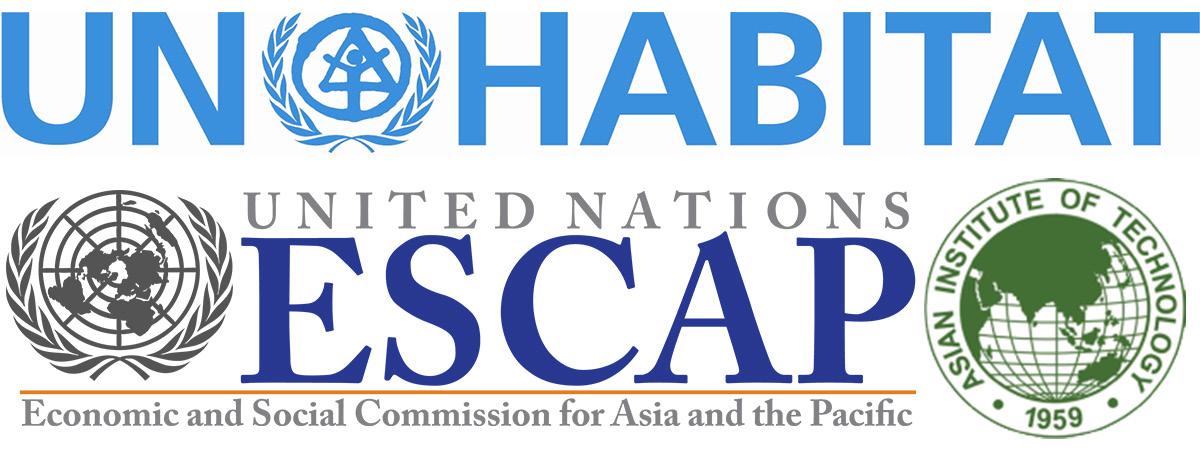
Structural Peer Review of Diamond Inya the Tallest Building in Myanmar
with AIT Consulting (AITC).

Suntac Technologies is a subsidiary of the Suntac Group of companies, established in April 1999 to enhance the rapid technological growth and infrastructural development within Myanmar through the provision of a comprehensive range of technological services.

Shwe Taung Development Co. Ltd., established in 1990 has been dedicated to achieve sustainable and healthy growth and has set out its mission to be a part of the rebuilding processes of the nation.
AITC Executive Director Dr. Naveed Anwar and Project Coordinator Engr. Thaung Htut Aung visited Myanmar to discuss the possible collaboration between AITC and the two organizations. Suntac is interested in software development collaboration for Building Construction Materials Estimation. Shwe Taung Group is collaborating with AIT Consulting, particularly for capacity building in the areas of construction management and structural engineering.

MYANMAR
"Recent Developments in Structural Design of Tall Buildings" Seminar, Conducted in Myanmar
On 12 September 2012, Myanmar Engineering Society (MES) in collaboration with AIT Consulting organized a seminar in Yangon on the recent developments in the structural design of tall buildings. The seminar was held at the MES building. MES members and invited structural and civil engineers attended the seminar which focused schematic design, structural systems, re-
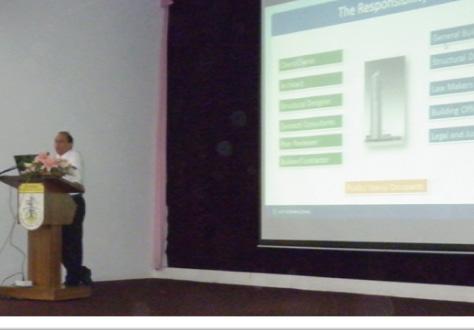
cent codes, standards and guidelines, seismic and wind loadings, analysis procedures, performancebased design, modeling, and the analysis and design issues in tall buildings. Dr. Naveed Anwar, Executive Director, and Engr. Thaung Htut Aung, Project Coordinator, both from AIT Consulting were the key speakers in the seminar.
Yangon, Myanmar Dr. Naveed Anwar (Top right) and Engr. Thaung Htut Aung (Bottom right)

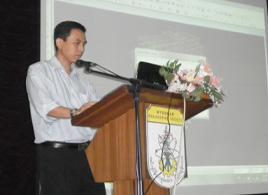
PAKISTAN
NUST Shows Interest to Initiate Educational Programs in Collaboration with AIT
AIT, Thailand NUST delegates at the AIT Consulting office
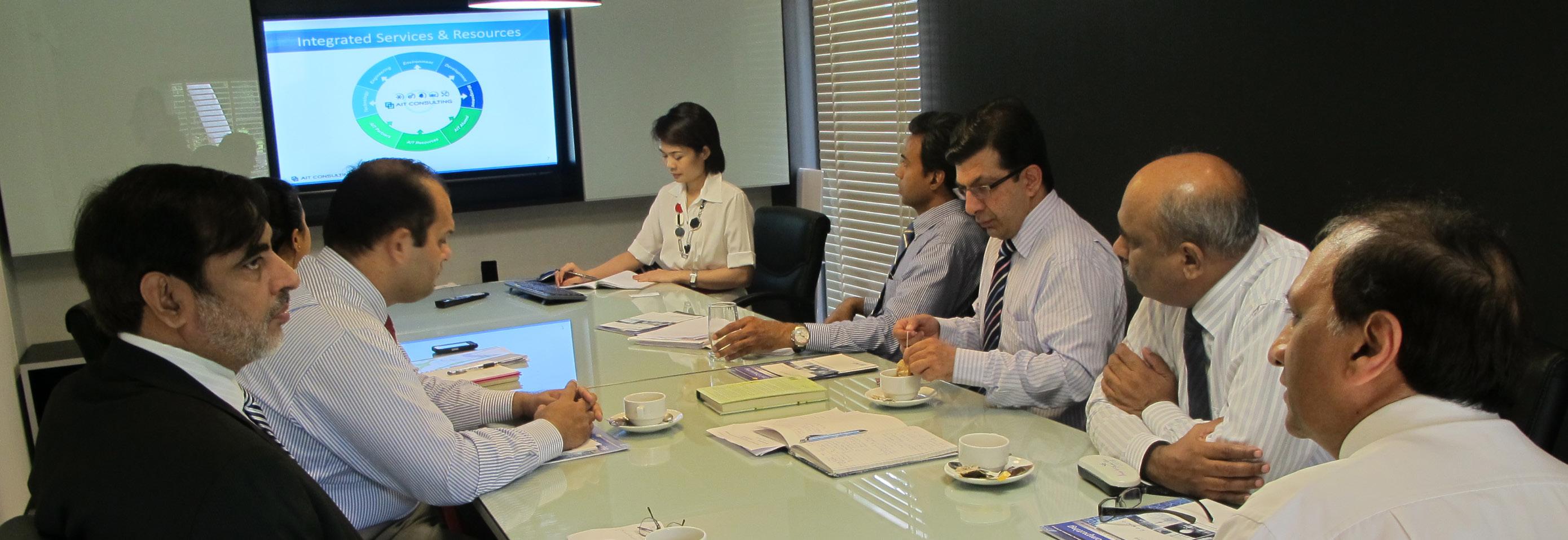
A delegation from the National University of Sciences and Technology (NUST), a public university founded by the government of Pakistan in 1981, led by Engineer Muhammad Asghar, Rector of NUST visited the Asian Institute of Technology (AIT) on 12 October 2012 to discuss mutual collaborative activities between AIT and NUST and to initiate programs of interests. graduate levels, two-stage undergraduate programs, faculty and student exchange programs, internship opportunities for AIT Undergraduate students, conducting joint research projects, and organizing joint international conferences in Pakistan and / or beyond the region.
The delegation toured around the campus and interacted with the AIT President, Vice Presidents, Deans, Professors, Directors, unit heads, NUST scholars at AIT, and AIT students from Pakistan. The delegation also visited AIT Consulting where Dr. Naveed Anwar briefed the group about the projects and activities of the organization. The delegation was impressed by AITC’s activities and is seeking collaboration between AITC and NUST Consulting for joint projects in Pakistan and beyond.
Manila, Philippines
ICCEE2012
SRI LANKA
A growing demand for building projects that use environmentally-friendly and energy-efficient materials implies an increased environmental awareness. Rising energy costs over the past few years have spurred a green movement in the construction industry worldwide. To further promote green building awareness, the Green Building Council of Sri Lanka (GBCSL) a national, non-profit organization that is committed to developing a sustainable property inA seminar focusing on Non-linear Analysis of Structures held on the 6 October 2012 in Sri Lanka was well attended by engineers from the Central Engineering Consultancy Bureau (CECB). Non-Linear Analysis, which is a key part of structural engineering, plays an important role in the design of new and existing buildings and is becoming a popular tool for performance evalu

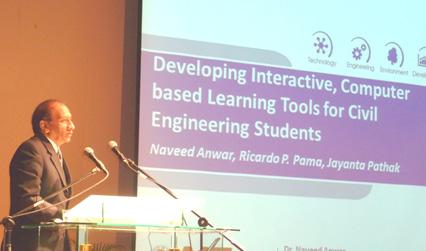
Dr. Naveed Anwar at the The Department of Civil Engineering, De La Salle University-Manila in cooperation with the Association of Civil Engineering Educators of the Philippines (ACEEP) hosted the ICCEE2012 – International Conference on Civil Engineering Education Conference 2012 with the theme “Addressing Global Challenges in Civil Engineering Education” on 9-10 November 2012.
The forum was held to establish a platform for Civil Engineering (CE) educators, researchers, practitioners, school administrators and students to exchange information, and share lessons and discuss strategies on how civil engineering education can be improved to produce globally competitive and socially responsible professional civil engineers. ICCEE2012 was comprised of keynote sessions by distinguished speakers, parallel sessions on a variety of topics by presenters from dustry for Sri Lanka, organized a symposium on “Greening the Construction Industry” held on 5 October 2012 at Hilton, Colombo. Among those invited was Dr. Naveed Anwar, Executive Director, AIT Consulting. The symposium was opened by by Prof. Ranjith Dissanayake, Chairman, Board of Education & Training of GBCSL, followed by a key note on Greening the Construction Industry by Prof. Sarath Kotagama, Professor of Environmental Science, University of Colombo. An address by the chief guest Mr. P. H. L. W. Perera, Secretary, Ministry of Construction, Engineering Service and Housing, concluded the symposium. ation of structural systems at the life safety and collapse prevention levels. AIT Consulting's Executive Director Dr. Naveed Anwar was invited by CECB’s Addl. General Manager Eng. K.L.S. Sahabandu, also Vice President of the Society of Structural Engineers Sri Lanka , to conduct the seminar. academe, industry and government, a seminar/ workshop on Outcomes-based Education for young Civil Engineering instructors, a student research poster presentation, ICCEE 2012 Awards, Various Exhibits and the 10th National CE Education Congress.
One of the keynote speeches delivered during the forum entitled “Developing Interactive, Computer-based Learning Tools for Civil Engineering Students” focused on the interactive application for the computer-aided learning of civil engineering curriculum (see full article on page 35). The paper was authored by Dr. Naveed Anwar, Executive Director, AIT Consulting, Asian Institute of Technology, Thailand; Prof. Ricardo P. Pama, President, University of the Cordilleras, Baguio City, Philippines and Prof. Jayanta Pathak, Professor, Civil Engineer

Non-linear Analysis of Structures seminar conducted at Central Engineering Consultancy Bureau, Sri Lanka
ing, Assam Engineering College, India.
Around 300 engineers from all over the world participated in the International Conference on Sustainable Built Environment (ICSBE-2012) held at Earls Regency, Kandy, Sri Lanka on 14 -16 December 2012. The ICSBE is a non-profit, educational organization with the mission to provide an international forum for the presentation and discussion of frontier research related to Sustainable Built Environment and their related technologies. The conference is embraced by the mainstream engineering community as the leading forum for the presentation of research and the place to build relationships with leading engineers in their field from around the world.

Dr. Naveed Anwar, Executive Director, AIT Consulting delivered a keynote speech at the conference on “Integrating Environmental Sustainability and Disaster Resilience in Building Codes” (see full article on page 16).
Ministry of Ports and Highways focuses on Sustainable Infrastructure Projects
The Ministry of Ports and Highways is the apex organization in Sri Lanka for the ports and highways sector and is responsible for the formulation of relevant policies programs and projects to achieve the socio-economic development, mobility, connectivity, and accessibility needs of the people of Sri Lanka. The Ministry’s vision is to become a leading partner in developing Sri Lanka as the “Emerging Wonder of Asia” by providing an island-wide modern road network and worldclass maritime facilities.

On 3 October 2012, Director, AIT Consulting, had the opportunity to meet Mr. R. W. R. Pemasiri, Secretary, Ministry of Ports and Highways, Sri Lanka to discuss a possible collaboration between the the two organizations. The meeting was also attended by Mr. L.V.S Weerakoon, Design Office (C.P.), Road Development Authority, and Ms. Ireshika Karunrathna, Assistant Consultant. The Ministry expressed keen interest in working together for both ongoing and future projects. Proposals covering the delivery of a Professional Development program on Public Private Partnership (PPP) for the transportation sector and a workshop in the area of sustainable infrastructure projects are currently being
Society of Structural Engineers, Sri Lanka
developed by AIT Consulting. On 3 October 2012, Dr. Naveed Anwar, Executive Dr. Naveed Anwar was invited for a dinner by the President of SSESL, Prof. Ruwan Weerasekera, also Professor of Civil Engineering (Division of Building and Structural Engineering) and Vice President of SSESL, and Engr. K.L.S. Sahabandu, also Corp. Additional General Manager, Central Engineering Consultancy Bureau. They discussed possible collaboration between SSESL and AIT Consulting and began planning for a workshop and training on the topic of Tall Building Design in 2013.
Sustainable Highway Infrastructure Workshop in Sri Lanka, a well-attended Event
More than 70 engineers and government officials involved in infrastructure and highway development projects in Sri Lanka attended the Sustainable Highway Infrastructure workshop. The workshop was organized by Ministry of Ports and Highways, Sri Lanka in collaboration with the University of Peradeniya, Sri Lanka and the Asian Institute of Technology, Thailand held on 16 December 2012.
The workshop’s theme focused on the need for new and existing infrastructure to comply with
THAILAND
high-quality technical standards, to meet strict environmental and health standards, and anticipate future demographic developments, in context of the 21st century.
The topics covered were relevant to the participants, emphasizing on the aspects of user costs, energy consumption, and long term environmental benefits as a sustainable solution for highway development. Dr. Naveed Anwar, Executive Director, AIT Consulting, opened the first session with an overview on Sustainable Infrastructure. Chief guest Mr. R.W.R. Pemasiri, Secretary, Ministry of Ports and Highways, Sri Lanka opened the seminar which was followed by four consecutive sessions providing the participants an overview on the environmental sustainability, green design, and construction practices of a given highway project.
For more information on sessions and experts please see page 41.
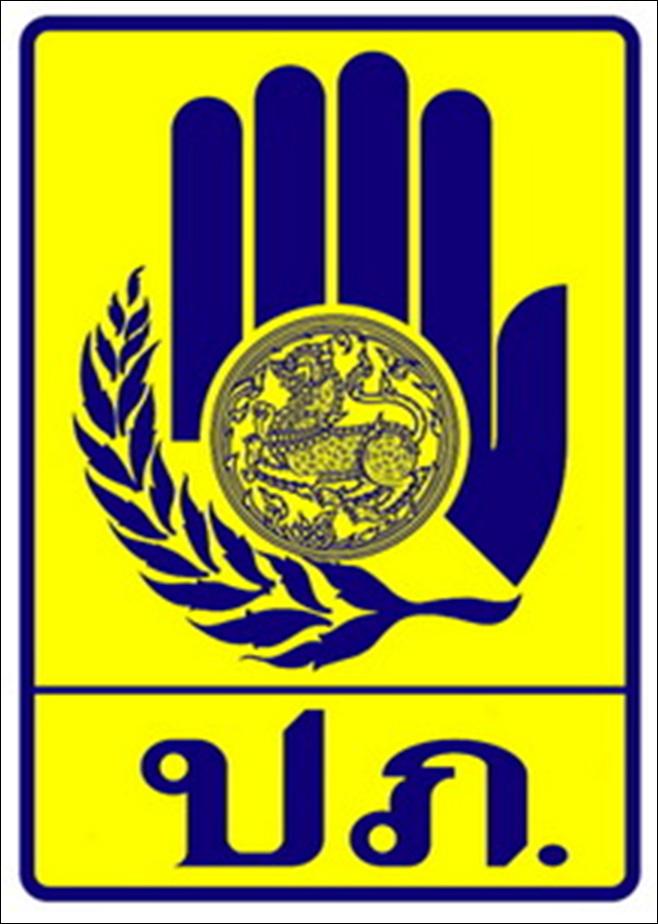
Thailand’s Department of Disaster Prevention and Mitigation (DDPM), Ministry of Interior is in the process of developing an Action Plan for Earthquake Disaster Prevention and Mitigation for Bangkok to establish a safe and secure urban environment against potential earthquakes.
DDPM engaged several international experts including Panya Consultants Co., Ltd. (PANYA), a Thai Consulting Organization focusing on services in socio-economic, environmental and technological areas and Dr. Pennung Warnitchai, a renowned expert and Associate Professor at the Structural Engineering field of study at AIT’s School of Engineering and Technology to assist in developing the plan. Dr. Warnitchai is highly accomplished in the structural engineering industry and has helped shape Thai government policy-making by serving on a number of expert teams for drafting national standards and amending the ministerial regulation. Dr. Warnitchai is also an expert member of the Board of Directors for Thailand's National Disaster Warning.
Dr. Warnitchai and his team, including engineers mobilized through AIT Consulting, will be responsible for conducting a probabilistic seismic hazard assessment (PSHA) and preparing PSHA maps for Bangkok for bedrock site condition, conducting and measuring the shear-wave velocity soil profiles in Bangkok, conducting seismic performance evaluation of buildings in Bangkok, developing and modifying the HAZUS computer code for studying the seismic risk of buildings in Bangkok, and evaluating the effect of an earthquake to Bangkok. The action plan is scheduled for completion by the end of 2013. AIT Consulting will be assisting in this development of the software and various other aspects.
AIT Consulting
Advisory Board and Technical Council discuss expansion to New Areas of Expertise
AIT, Thailand AIT Consulting's Advisory Board
The second meeting of the board and council was held on 7 August 2012 at the AIT Consulting (AITC) office. AITC's Semi-Annual Report was presented highlighting the various projects, proposals, and activities executed in 2012. The newly established Innovation and Intellectual Property Rights Unit, Quality Management System and the recent office renovation were also discussed during the meeting.
The Advisory Board meeting focused on resource management and AITC's expansion to more areas of expertise, particularly, Energy, IT & GIS, and Management. Topics covered within the Technical Council meeting also centered on AIT Consulting’s expansion, resource management, and proposed initiatives such as E-learning and Mobile Application development.
The Advisory Board and Technical Council are the key elements of AITC’s overall organizational structure, established to drive the organization forward and take an active role in overall operations and growth. The Advisory Board is comprised of representatives from AIT’s partner institutions, international organizations, industry representatives, AIT alumni and members of the AIT Administration and provides overall guidance for the office. The Technical Council members are
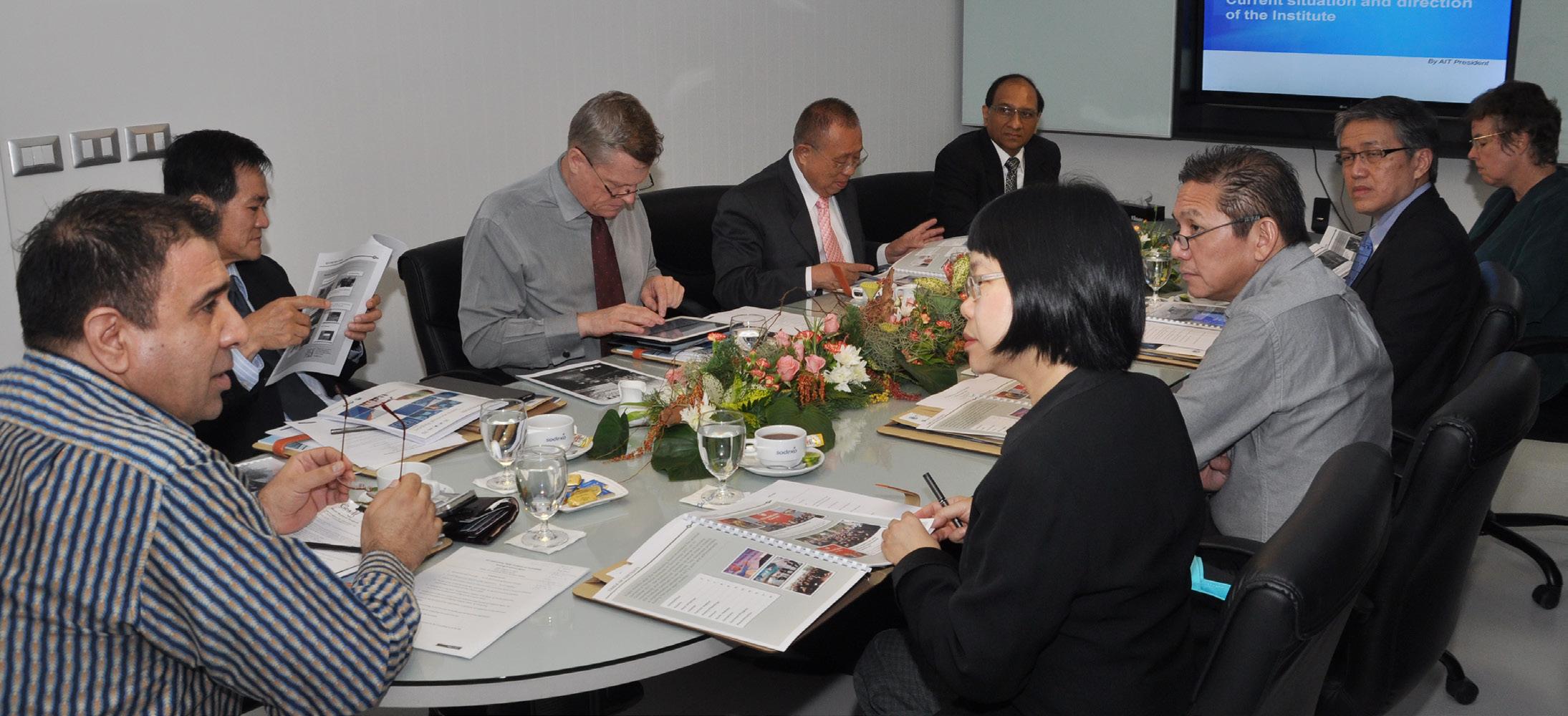
comprised of members from the AIT administration, deans of the schools, faculty members, and directors of various centers at AIT, and offer guidance and advice on technical matters related to the projects undertaken by AITC.
Advisory Board members
Prof. Said Irandoust, President, Asian Institute of Technology (meeting Chair)
Mr. Jose A. Sy, President and CEO of SY^2+ Associates
Prof. Elizabeth Siew Kuan Ng, Director, LLM, Faculty of Law, NUS
Mr. Vatana Supornpaibul, Director, Executive Director, Amata Corp
Prof. Worsak Kanok-Nukulchai, Vice President, Resource Development, AIT
Dr. Barbara Igel, Dean, School of Management, AIT
Dr. Jonathan Shaw, Executive Director, AIT Extension
Mr. Tuck Oon Choong, AIT Senior Alumni
Dr. Naveed Anwar, Executive Director, AIT Consulting and Board Secretary
Technical Council members
Dr. Barbara Igel, Dean, School of Management
Professor Sivanappan Kumar, Professor of Energy Field of Study, AIT
Dr. Pennung Wanitchai, Associate Professor of Structural Engineering, AIT
Dr. Sandro Calvani, Director of ARCMDG, AIT
Dr. Saeed Zaki, Managing Director of dwp
Dr. Naveed Anwar, Executive Director of AIT Consulting and Council Secretary
AIT Consulting moves back to Newly Rebuilt Office after the Flood
Before Flood
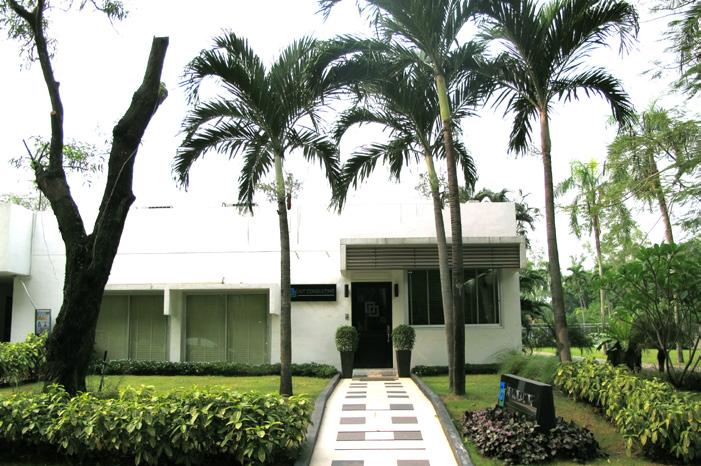
The first of June 2012 marked AIT Consulting's return to its fully refurbished office at the Asian Institute of Technology (AIT), Pathumthani, after a temporary relocation to Two Pacific Place, Sukhumvit, Bangkok for almost six months. Its relocation since the 21 October 2011 was necessitated by the floods of the 2011 monsoon, which AIT Consulting A new unit called the Innovation and Intellectual Property Rights (IIPR), headed by Dr. Siddharth Jabade, was recently launched by AIT to be housed in AIT Consulting. IIPR will serve to facilitate the effective use of the IP system to retain competitiveness, maximize profits and accelerate sustainable development. The unit will spearhead activities related to the identification and protection of inventions, system developments for routing these inventions, and capacity building to create IP awareness. All of the above prioritize the protection of in-house inventions from AIT. The newly established unit now plays a role in one of the Asian Institute of Technology’s (AIT) prime 5-year research on sustainable decentralDuring Flood
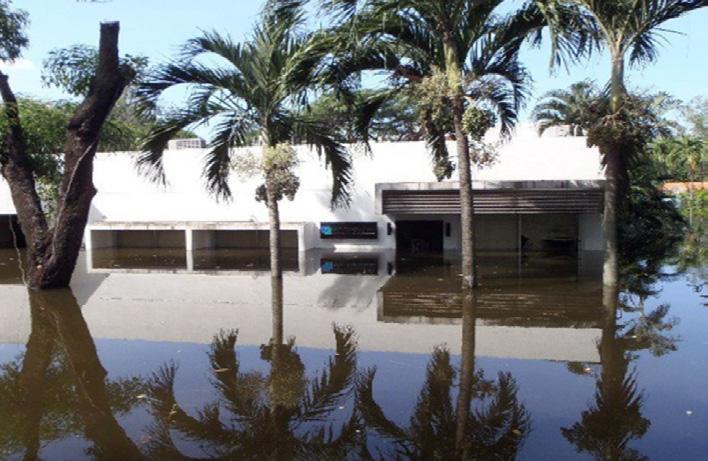
devastated 65 of Thailand's 77 provinces. The AIT campus also succumbed to the flood waters and was completely inundated with some areas submerged up to three meters for over two months.
Rebuilding the new office began early in April 2012. AIT Consulting utilized in-house architects ized wastewater management. This research, led by Dr. Thammarat Koottatep, Associate Professor at AIT’s School of Environment, Resources and Development (SERD), Environmental Engineering and Management (EEM) field of study, received a 5M USD grant from the Bill and Melinda Gates Foundation through the Reinventing the Toilet program. IIPR is tasked to establish the structured innovation management process which includes the integration of IP and integrated process from ideation stage. Specifically, the IIPR unit will be involved in detailed patent search, patent analysis, patent landscape, technology gap assessment, patentability evaluation, design of experiments, patent cluster design, drafting and filing of applications in Thailand and other countries. After Flood
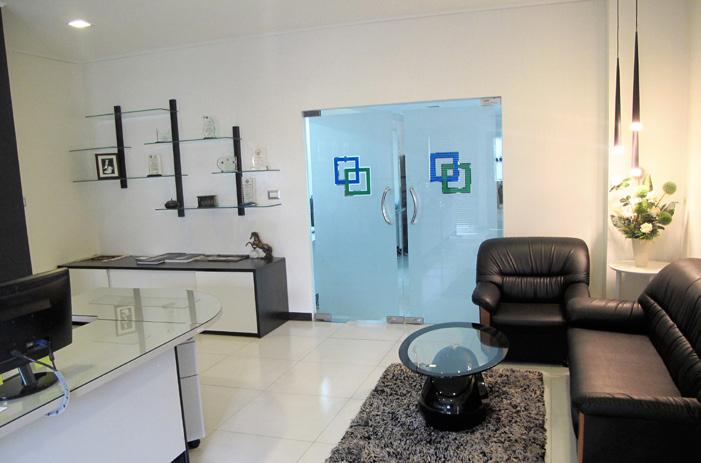
to redesign the office. Though the existing building structure remained the same, the interior was remodeled to increase inter-unit accessibility,
Innovation and Intellectual Property Rights Unit launched in
38 companies join AIT Career Fair
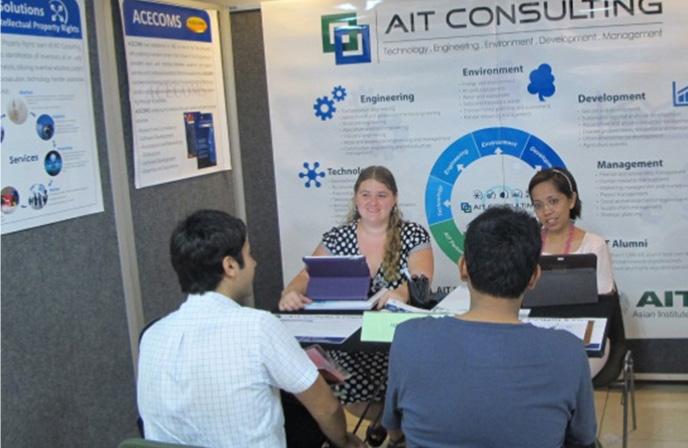

functionality, and energy efficiency.
AIT Consulting booth at the career fair
A record number of 38 companies, with several industry recruiters from Vietnam and Malaysia, joined the bi-annual AIT Career Fair held early November.
The career fair offered a full range of job placement availabilities, internship opportunities, information on long-term career prospects, on-the-job training, research partners, and opportunities for networking with company representatives. The fair was held at the AIT Conference Center and attracted a healthy number of AIT students.
AIT Consulting was among the companies that joined the Career Fair to recruit future employees and showcase the organization’s projects and activities to the broader AIT Community. The booth, managed by Mrs. Clarisa Cuarez, Human Resource Manager and Mrs. Olga Shipina, Marketing Officer, was visited by over 100 job seekers and inquiring students.
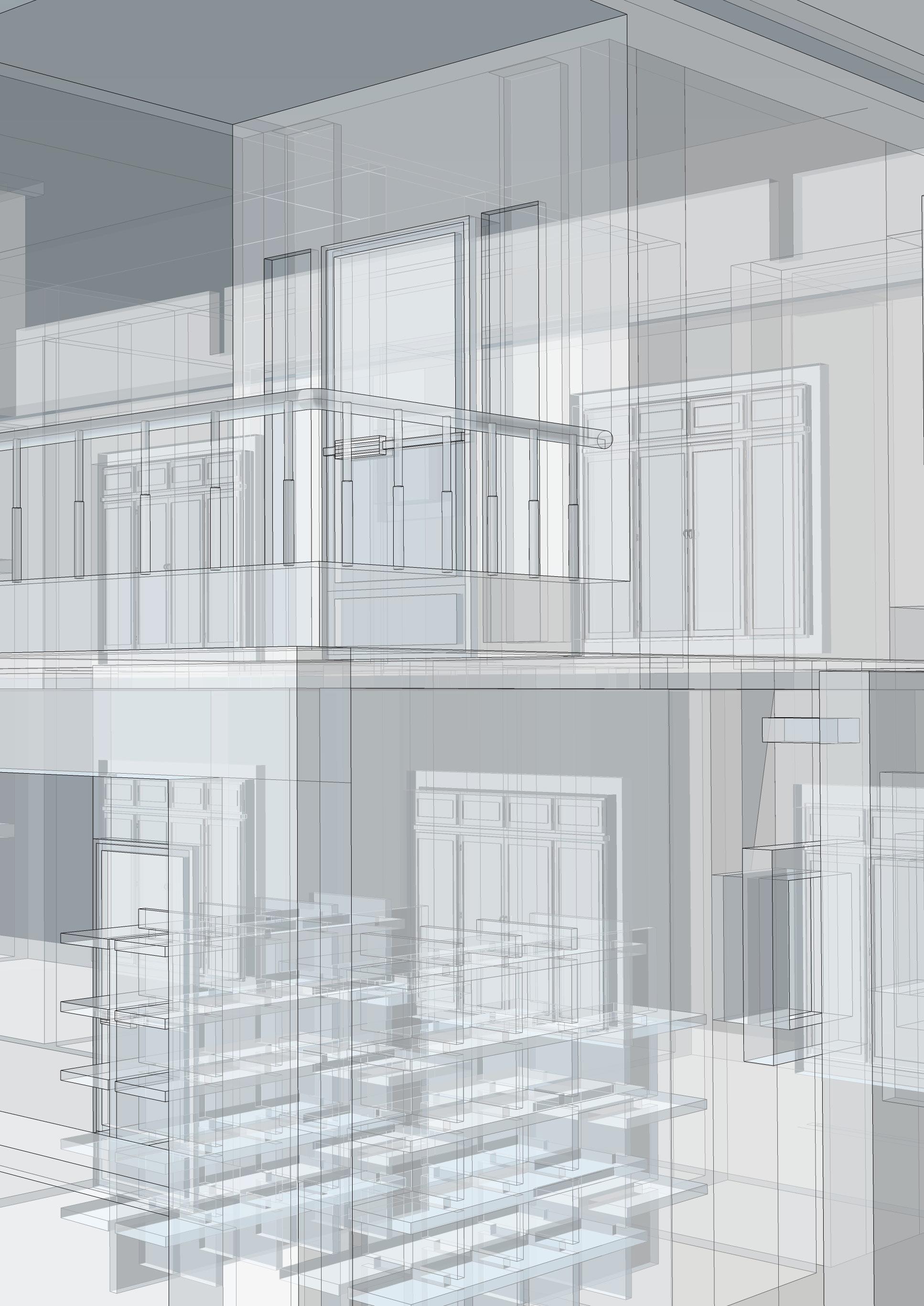
By Dr. Naveed Anwar, Adnan H. Aliani, and Wathanyu Amatyakul

Background
Buildings constructed today are likely to dictate city and town development and consumption patterns for the next 20 to 30 years. The way we design, build, and maintain our buildings will influence the sustainability of a city and the health and safety of its inhabitants for decades to come. Today, many problems that cities cope with can be addressed by using and enforcing building codes. Disaster resilience, energy efficiency, and prevention of diseases are all issues that are influenced by building codes. Resilience to earthquakes, for example, is very much linked to construction. In earthquakes of approximately the same strength, 2 people died in California (United States, 2003), while 41,000 people lost their lives in Bam (Iran, 2004). Experts agree that most of the difference is attributed to the high standards of earthquake safety that California sets in its building code. In other words, many lives could have been saved by implementing and enforcing better building codes. The same is true for extreme weather events like cyclones and hurricanes, which are likely to occur more often with climate change; much of the destruction can be prevented by constructing safer buildings.
For environmental issues, buildings are extremely important too. Buildings consume energy in all phases of their lifecycle. Designing and constructing buildings that use resources efficiently is one of the best ways to address sustainability in a city. By incorporating disaster resilience and environmental design in the building codes, buildings in the future can be more people and environment friendly. This will decrease the carbon-footprint of cities and their impact on the environment, while increasing people’s quality of life.
Authors: Naveed Anwar, P.hD.
Executive Director, AIT Consulting
Adnan H Aliani
General Secretary, United Nations Economic and Social Commission for Asia and the Pacific
Wathanyu Amatyakul, P.hD.
Researcher, Asian Institute of Technology Most of the cities in the Asia-Pacific region are experiencing rapid urbanization and increased energy use (Figure 1). To accommodate the influx of these people, many buildings will be built in these cities in the coming years. Building growth is expected to be higher in the developing cities in Asia as it is less developed compared to developed cities in the world. In many of these developing Asia-Pacific countries, buildings are not built in an environmentally friendly manner as often times, current building codes do not take into account environmental issues and some of these countries lack building codes, or have codes with very low compliance rates. Therefore, improving the building codes of developing countries will have a greater impact as building growth is expected to be higher in this region and the responsibility is shared between various stakeholders (Figure 2) for their implementation, training and creating awareness among practicing engineers.
Government Updating of codes, monitoring and evalution of code implementation, technical support
Municipality Inclusion of building code in building permit system, training
Asia
Buildings in Asia
100%
100%
27.6%
13.8% 3.7% 7.3%
Figure 1 Asia’s growing share of world energy use
35.2%
11.2%
Study Objectives
The overall research objective is to identify elements of environmental sustainability and disaster resilience both vertically, across government levels, and horizontally, across construction sectors, in codes that govern planning, design and construction of buildings in urban areas that can be integrated into building codes in developing countries in the Asia Pacific region. The specific objective of this research is to gain an overview of the current integration of environmental sustainability and disaster resilience in building codes and building code compliance in the Asia-Pacific region, the challenges, and strategies in building code enforcement, and to identify good practices in enforcing building codes.
Research Design
Methodology
The methodology used for this study is briefly mentioned below.
Identify Reference and Target Country
The main objective is to review the building codes of countries that are known to have integrated environmental sustainability and disaster resilience in their existing building codes and to identify elements of environmental sustainability and disaster resilience in these codes that can be integrated in building codes in developing countries in the Asia Pacific region. The first step involved identifying countries that are known to have integrated environmental sustainability and disaster resilience in their building codes. These countries will serve as the reference countries. In addition, the developing countries in the Asia Pacific region identified were known to have poor building codes; these will serve as the target countries.
Professional and Civil Society Awareness programs, peer review, training, seminar and publication
The building codes of the reference and target countries were reviewed to determine the elements of environmental sustainability and disaster resilience. An analytical framework was developed to determine the integration of the elements of environment sustainability and disaster resilience for the reference and target countries.
Analyze the Building Codes
The building codes of the reference and target countries were analyzed based on the analytical framework that was developed in the previous step.
Integrate Environmental Sustainability and Disaster Resilience in Building Codes
Based on the analysis, the element of environmental sustainability and disaster resilience that was integrated in the building codes was compared among the reference and target countries. The elements of the building codes from the reference countries that can be integrated into the building codes of the target countries were identified.
Organize Expert Group Meeting to Identify Challenges and Strategies in Building Code Enforcement
Even though there are building codes in some of the developing countries, the building codes do not have any value, as developers and designers do not comply with the codes. To make the building codes effective, the code has to be enforced. To identify the challenges and strategies in enforcing building code, the researchers organized an expert group meeting.
Identify Good Practices in Enforcing Building Codes
To make the building codes effective, it has to be first enforced. Through literature review and Expert Group Meetings, good practices were identified in enforcing building codes.
Analytical Framework
Building codes can be used to regulate many different aspects such as structural strength, accessibility, health, and safety. These regulations are integrated in technical provisions, which are grouped in categories. Categories differ from country to country. This research used the following categorization:
1. Structural Design
2. Building Materials
3. Buildings and Services (including building envelope, lighting, ventilation, heating, air-conditioning, and electrical, mechanical, and energy systems) 6. Landscaping
7. Construction Practices
The scope of this research project limits that the only prescriptions that will be analyzed are those that address environmental sustainability and disaster resilience. These can be grouped under any of the above categories. In environmental sustainability, for example, prescriptions minimizing water loss may appear under ‘plumbing’, while rules prohibiting the use of energy intensive appliances would be grouped under ‘buildings and services’. For this research the following six categories were identified for environmental sustainability.
1. Material Conservation & Resource Efficiency
This element deals with the need to minimize the amount of resources used to increase the use of environmentally friendly materials.
2. Energy Conservation & Efficiency
This element includes regulations aiming to minimize energy use and maximize the use of renewable energy sources.
3. Water Conservation
This element includes prescriptions that minimize water use both within (water conserving fixtures) and around (water retention facilities) the house.
4. Soil & Land Conservation
Regulations related to this element include those that attempt to avoid wind erosion of the land surrounding the building.
5. Solid Waste Reduction
Building codes can address solid waste reduction both during construction (construction waste) and during use (household waste).
6. Air Pollution Control
This element deals with the potential of buildings to minimize air pollution. An example is by using environmentally friendly building materials or by building green roofs and using plants around the building.
For a building code to have integrated environmental sustainability well, it should address all six categories. However, some issues may be more important than others, depending on the local context. Similar to environmental sustainability, six categories has been identified for disaster resilience.
This element addresses factors such as mean roof height, design pressure, wind velocity, and connections between roofing felt and sheet metal.
2. Snow Load Resistance
This includes prescriptions for the strength of the roof and other structural elements.
3. Seismic Load Resistance
To withstand earthquakes, a building should use a certain minimum quality of building materials and have a strong structure.
4. Rain & Flood Load Resistance
Examples of prescriptions under this category are raising the ground floor above average flood levels or re-siting buildings outside flood-prone areas. Prescriptions under this heading help to prevent the spread of bushfires and minimize the impact such as prescribing fire resistant materials.
6. Landslide Resistance
This includes prescriptions detailing how to minimize damage when the ground under the house would move.
As opposed to environmental sustainability, a building code does not need to address all of these six categories in order to have 'well implemented’ disaster resilience. It depends on the relevance of the disaster to a country. In tropical countries, snow load resistance is usually not an issue, while in dry countries, floods are not likely to happen. Some of the above elements of environmental sustainability and disaster resilience can only be addressed under one building code category while others should be dealt with in more categories. The diagram in Figure 3 shows how this could be done. This model was used as the analytical framework.
Structural Design
Wind Loads Resistance
Seimic Loads Resistance
Flood Loads Resistance
Snow Loads Building Materials
Material Conservation
Air Pollution Reduction
Analytical Framework
Resistance
Building Services
Water Conservation
Air Pollution Reduction Fire Prevention
Water Conservation
Fire Resistance
Fire Resistance Landscaping
Water Conservation
Soil/Land Conservation
Air Pollution Control Constructional Practices
Material Coservation
Energy Conservation
Water Conservation
Soil/Land Conservation
Land slide Resistance Waste Reduction
Wildfire Resistance Air Pollution Control
Figure 3 Analytical framework: The six elements of disaster resilience (red) and the six elements of environmental sustainability (green) should ideally be integrated under the above categories
Analysis of Building Codes
All of the target and reference countries have some type of rule governing building. In most countries analyzed, these rules are included in a proper building code issued under one single law, but in Thailand, the regulations are scattered over various ministries and therefore less coherent. In Sri Lanka, the same is true, but moreover, these regulations only apply to the city of Colombo.
Another difference between the countries is that some countries have a prescriptive building code, outlining exactly which materials and which techniques can be used (USA-California, India, Bangladesh, Thailand, Sri Lanka, and the Philippines), while others have a performance-based building code, which only states the minimum or maximum values a building design has to live up to, leaving it to the owner, developer and/or designer to decide how to make sure that happens (Singapore, Australia and the UK). Although performance-based building codes allow more flexibility and innovations, it is harder for developing countries to implement them since it requires a lot of capacity from architects, engineers, and local government staff to make and check such calculations.
There are but a few countries that have integrated all aspects of environmental sustainability Integration of Environmental Sustainability and Disaster Resilience in the Building Codes
Originally, building codes were adopted to improve safety and health in and around buildings. The concept of using however, also many elements that are not well addressed including land and soil conservation, air pollution and solid by including landscaping regulations. One example is to
a building code to address environmental concerns is relaand constructional practices, water in the section on plumb
tively new to developing countries in the Asia-Pacific region. This is why not all environmental sustainability aspects have been dealt with sufficiently in their building codes.
USA-California, Singapore, and India have integrated all aspects of environmental sustainability. In case of California and Singapore, these requirements are followed, but in India, compliance is generally low. Other reference countries (Australia and the UK) have only integrated a few elements. The most well integrated element is energy efficiency. All lines, and then transferred to mandatory, but separate
countries either already have requirements for energy efficiency or are working on it. All building codes and regulations discussed have been updated recently, with Australia updating their code annually, except for Bangladesh and Sri Lanka, both countries are currently in the process of updating.
Water conservation is another element that is relatively well implemented, especially in reference countries. There are,
Environmental Sustainability
USA Singapore Australia
Material conservation & Resource efficiency
Energy conservation & efficiency
Water conservation
Land and soil conservation
waste reduction. The building codes in Singapore, California, and India address the environment around the house minimize air pollution and to improve water and soil conservation.
Interestingly, all reference countries have integrated energy efficiency and water efficiency with the other chapters of the code (energy in the sections dealing with appliances ing), but all other elements of environmental sustainability are generally dealt with in a separate ‘green code’ (such as the California Green Building Code or the Code of Environmental Sustainability in Singapore) and not integrated with the other requirements.
Target countries have similarly isolated energy efficiency, which is usually addressed in a separate building code which is not mandatory or not enforced, while most other elements of environmental sustainability are not addressed at all. Apparently, prescriptions relating to environmental sustainability are usually first included in voluntary guideSoil waste reduction
building codes, before they are mainstreamed into the ‘normal’ chapters of the main building code.
UK Thailand India Bangladesh Philippines Sri Lanka
updating
updating voluntary updating
Air pollution control
Figure 4 Integration of Environmental Sustainability in Building Codes and Regulations = integrated, = integration status undetermined
Not all countries are equally prone to all disasters, and therefore, some disaster resilience elements are not applicable everywhere. Almost all the disaster resilience prescriptions have been included in the building code chapters on structural design. The only exception is fire resistance where in India and California, there is a separate code for fire safety; while the Philippines has requirements for fire-resistant construction materials.
Wind load resistance has been integrated in the code of all countries. Only Sri Lanka has voluntary prescriptions, other countries have mandatory rules that should safeguard seismic loads; all countries that are prone to earthquakes have addressed this in their building code. This is not surprising, since this is the common reason for countries to draft a building code in the first place. Snow loads have Technology | January 2013
been addressed in each country that is vulnerable to it, except for the UK.
Less well addressed are rain & flood loads and landslide resistance. Out of the target countries, Bangladesh has the only code that currently addresses floods and is in the process of updating them. In 2011, many countries in South and South-East Asia were affected by major floods, leaving many homes damaged or even destroyed. With climate buildings from storms and typhoons. The same is true for
change, it is expected that such floods and the related loss of lives and goods, will happen more often, unless countries adapt.
Incorporating flood loads and landslide resistance in building codes and enforcing those is one good step in that direction. The reference building codes from the USA and Australia could serve as an example. Wildfire and bushfire
resistance is another element that is not integrated in most building codes analyzed. The Philippines is the only country addressing it in their building code. Again, the building codes of the USA and Australia, and the regulations of the Philippines could be used as an example for integrating
Disaster Resilience
USA Singapore Australia
this element into other target country building codes as necessary. In India, the building code gives the local authorities directions on how to construct safe buildings in areas that are prone to more than one disaster.
UK Thailand India Bangladesh Philippines Sri Lanka
Wind Load
Snow Load
Seismic Load
Rain and Flood
Wildfire and Bushfire Resistance
Landslide Resistance N/A
N/A
N/A N/A N/A
N/A
N/A
Figure 5 Integration of Disaster Resilience in the Building Codes and Regulations = integrated, = integration status undetermined N/A N/A
updating voluntary
N/A
N/A
N/A
Building Code Enforcement
Even when countries have a building code that incorporates environmental sustainability and disaster resilience, it is often poorly enforced. In the Expert Group Meeting the participants identified the challenges which are provided in the table below.
Table 1 Challenges and Strategies in Building Code Enforcement
Challenges
Lack of Awareness
Strategies to Overcome
• Invest in education; both in the curriculum and in building strong school buildings as demonstration projects
• Build linkages with academic institutions
• Use the mass media and organize large-scale events such as ‘earthquake awareness day’ or ‘building code day’
Code-compliant buildings are more expensive to construct
• Establish different building codes for different buildings; complicated buildings should use a more sophisticated code than simple houses (e.g. Nepal).
• The code documents should be affordable and easily accessible
Lack of Capacity and Knowledge
• Implement continuous training programmes to professionals, contractors and masons. Start with formal education curricula, but also use mobile training facilities and international development projects to build capacity
• Use third party verification by government accredited agencies/firms/individuals (e.g. China, Republic of Korea) if local government doesn’t have the capacity to check building permit applications
• Use South-South learning to exchange experiences
Accountability and Enforcement Framework
• Implement financial, fiscal or zoning incentives (e.g. India, Republic of Korea, Japan)
• Make housing loans dependent upon completion certificate
• Establish a stronger penalty system for corruption and non-compliance, particularly for larger, more complex buildings
Lack of coordination between authorities
• Establish one regulatory body to coordinate enforcement
• Set up an awareness raising program to inform stakeholders about their roles
References
Bangladesh National Building Code 1993
California Building Standards Code 2010
California Green Building Standards Code 2010
Code of Practice for Energy Efficiency in Buildings 2007
India Energy Conservation Building Code 2007
Guidelines for Housing Development in Coastal Sri Lanka 2005
National Building Code of India 2005
National Building Code of the Philippines 1977, updated 2004
National Construction Code of Australia 2011 (containing Building Code and Plumbing Code of Australia 2011)
Planning and Building Regulations of the city of Colombo 1999
Singapore Building Control Regulations 2003 (including Building Code)
Singapore Building Control (Environmental Sustainability) Regulations 2008 Sri Lanka Manual for Building Design for High Winds 2008
Thailand Ministerial Regulations on Building Control (1984, 2008)
Thailand Ministerial Regulations on Building Design for Energy Conservation2009 Good Practices of Building Code Enforcement Almost all countries in the Asia-Pacific region have building codes. However, not all building codes incorporate elements of environmental sustainability and disaster resilience and not all codes are enforced strongly. ESCAP and AIT documented six practices in the Asia-Pacific region that were successful in increasing the share of green and/or resilient buildings. Some of the practices are presented below:
1. Keep it simple.
Nepal didn’t have a building code until 2003. That building code has four different levels: the simpler the building design, the simpler the rules set for the design in the code. However, there is a need of strong building code enforcement. The city of Dharan decided to make compliance even easier and start with five rules that all new construction should follow. By explaining these rules to all stakeholders involved, compliance has risen quickly.
2. Raise awareness.
In central Vietnam, the NGO Development Workshop France has set up a programme to strengthen existing housing against damage caused by typhoons. The basis of the programme are ten simple construction rules, but the strength of the programme lies in the extensive awareness raising programme, which includes cultural events, radio and television broadcasts and adapting local myths and lyrics of songs to explain the importance of disaster preparedness. When one strengthens one’s house according to above-mentioned ten rules, one can apply for a special housing loan.
3. Provide incentives.
Incentives, in whatever way, shape or form, can be a very effective means of encouraging compliance, as it can reduce the costs for the developer or buyer. Three major types of incentives were explored for this report:
a. Offer special housing loans.
In India, the National Housing Bank, with support from the German KfW Development Bank, established a housing loan programme where availability of loans is made dependent upon energy savings. Only when a new building is expected to consume 30 per cent less energy than a reference building, the developer is eligible for this specific housing loan, and the buyers of the apartments are eligible for sub-loans. Although additional incentives haven’t been implemented yet in India, the programme could be made more attractive for developers by offering lower interest rates or preferential tax treatment.
Methods to Implement Building Codes Effectively
Several methods have been identified to implement building codes effectively which are briefly discussed below.
1. Flexibility vs. simplicity: introduce a building code with various levels.
National governments are often the main driver for developing or reviewing a building code. A proper building code needs to be laid down in a law, such as the Building Act, to make enforcement possible. A basic precondition for any code development process is good cooperation between all relevant stakeholders, including national and local governments, architects, engineers and developers. This is important to avoid problems at the local level with implementing complex or impractical building codes developed at the national level. To resolve the issue of implementing complex building codes separate building codes for different types of buildings can be developed. Every building developer in the Republic of Korea must choose which energy saving measures he wants to implement from a list provided by the government. Every implemented measure is awarded with points. To receive a construction permit, one has to implement at least 60 points worth of measures. But if one manages to implement more than 70, 80 or even 90 points, zoning restrictions (e.g. maximum building height) are increasingly relaxed. In cities where space is scarce, developers can often earn back the extra investment in energy efficiency by renting out or selling this extra floor space, while it doesn’t require any additional investment from the government.
c. Offer tax breaks.
Japan has chosen to look at housing from several viewpoints: housing quality (quality of construction material and techniques), safety (seismic resistance), environmental sustainability (energy and water efficiency) and the aging population (adaptability). Owners and developers who build or retrofit their houses according to certain quality standards set by the government can apply for a ‘Long-life Quality Housing 'certificate’. With this certificate, they are eligible for tax breaks on their income, real estate and individual inhabitant tax. Even though the programme started less than three years ago, around 25% of all newly built detached houses are certified.
4. Attack the issue from all sides.
Singapore has made green building a national priority and has, for this purpose, drafted a green building master plan. Under this master plan, a variety of incentives for greening new and existing buildings have been established including partly mandatory for the minimum requirements set in the building code are raised every few years and are enforced strongly, and partly voluntary highlighting financial incentives, educational programmes, and awareness raising. Different instruments are geared towards different stakeholders such as technicians, CEOs, and project managers. The programme would not have been as successful as it is without the strong political backing shown by various government agencies.
5. Transfer responsibility to the private sector.
With the economic boom, more and more complex buildings were constructed in Chinese cities. Now, certified Supervision Companies are charged with this task; only with their signature for compliance can building developers get a building permit. This reduces the need for capacity building in every single local government and also transfers the checking cost from the public to the private sector.
2. Low capacity in local governments: introduce private sector supervision.
Building plans have to be checked for compliance by local government staff but some local governments may lack the technical capacity to review complex plans. In such cases compliance checking of technically complex plans can be outsourced to private supervision companies.
3. Low awareness: incentivizing developers and owners.
This has already been discussed in the good practices section. National and local governments are important stakeholders to increase building code compliance, but owners and developers play a major role, too. They are the ones who will have to invest their time and money in constructing a building with higher quality, while it is usually easier and cheaper in the short term to construct a non-compliant building. When considering incentives to persuade them, it is important to recognize the difference between smaller low-cost housing projects and big commercial projects. The people paying for construction have different motives in investing, varied incentives should be made available.
Originally, building codes in the Asia Pacific region were phoons were integrated as evident in all the building aimed at improving health and safety in and around buildcodes analyzed. Resistance against earthquakes is also well ings. The concept of using building codes to further enviintegrated. All countries that lie in or are close to seismironmental design is something relatively new in the region. cally active areas have sections on seismic loads. There are, This is mainly why, in Asian buildhowever, other important elements ing codes, disaster resilience is usually better covered than enviTo ensure a sustainable and of disaster resilience that some countries have not been dealing with well. ronmental design. disaster resilient city, nationFloods, landslides, and wildfires are al and local governments hazards overlooked in most building Five countries were considered as codes. reference countries. The analysis need to focus on integrating of the building codes of a total of environmental sustainabilThe documented good practices nine countries demonstrated that out of all the target developing ity in building codes show that this can start both from the national and the local level. It may be countries, India is the only couneasier to raise awareness, from the lotry that has addressed all six elements of environmental cal level in order to reach the general public. When a strong design. However, most of the building codes are voluntary regulatory system is in place, starting enforcement from the and the parts that are mandatory are usually not much national level may be more effective, for example by implecomplied with. menting nation-wide fiscal, financial, or zoning incentives.
Other target countries only address energy efficiency, although also mostly in a voluntary way and in a less comprehensive way than the reference developed countries have done. Solid waste management, air pollution control and land & soil conservation are items that are relatively new, even to reference country building codes.
The conclusions with regards to disaster resilience are slightly more positive. Resistance against storms and tyTo ensure a sustainable and disaster resilient city, national and local governments should focus on integrating environmental sustainability and disaster resilience in building codes and also focus on enforcing the building codes in practice. To encourage developers and designers to build environmental friendly and disaster resilient buildings, governments may provide them incentives.
CTBUH 2013 – International Conference The Council on Tall Buildings and Urban Habitat (CTBUH)
11–13 June | The Brewery | London, UK
Important conference discussions
What functions, ground floor solutions and building expressions are appropriate for a European skyscraper?
• How tall is “tall” in a historical context? Should there be more sensitivity around height?
• Do these buildings really deliver the oft-stated sustainable advantages?
• Can they reduce,generate and store energy in ways to benefit the city as a whole?

• How can these most modern of architectural wonders integrate into the historic city to act as mediators between the present and the past?
Important Conference Dates Pre-Conference Cocktail Reception:
June 10, 2013
Speaker Sessions:
June 11-12, 2013
Conference Dinner:
June 11, 2013
Networking Reception:
June 12, 2013
All Day Technical Tours:
June 13, 2013
For more information please go to:




